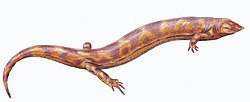Ostodolepidae: Difference between revisions
Created page |
RjwilmsiBot (talk | contribs) m fixing page range dashes using AWB (7151) |
||
| Line 23: | Line 23: | ||
}} |
}} |
||
'''Ostodolepidae''' is an extinct [[family (biology)|family]] of [[Tuditanomorpha|tuditanomorph]] [[microsaur]]s. They are unique among microsaurs in that they were large, reaching lengths of up to {{convert|2|ft|cm}}, terrestrial, and presumably [[fossorial]].<ref name=ASR09>{{cite journal |last=Anderson |first=J.S. |coauthors=Scott, D.; and Reisz, R.R. |year=2009 |title=''Nannaroter mckinziei'', a new ostodolepid ‘microsaur’ (Tetrapoda, Lepospondyli, Recumbirostra) from the Early Permian of Richards Spur (Ft. Sill), Oklahoma |journal=Journal of Vertebrate Paleontology |volume=29 |issue=2 |pages= |
'''Ostodolepidae''' is an extinct [[family (biology)|family]] of [[Tuditanomorpha|tuditanomorph]] [[microsaur]]s. They are unique among microsaurs in that they were large, reaching lengths of up to {{convert|2|ft|cm}}, terrestrial, and presumably [[fossorial]].<ref name=ASR09>{{cite journal |last=Anderson |first=J.S. |coauthors=Scott, D.; and Reisz, R.R. |year=2009 |title=''Nannaroter mckinziei'', a new ostodolepid ‘microsaur’ (Tetrapoda, Lepospondyli, Recumbirostra) from the Early Permian of Richards Spur (Ft. Sill), Oklahoma |journal=Journal of Vertebrate Paleontology |volume=29 |issue=2 |pages=379–388 |doi=10.1671/039.029.0222}}</ref> Ostodolepid remains have been found from [[Early Permian]] beds in [[Texas]] and [[Oklahoma]].<ref name=CG78>{{cite journal |last=Carroll |first=R. L. |coauthors=and Gaskill, P.|year=1978 |title=The Order Microsauria |journal=Memoirs of the American Philosophical Society |volume=126}}</ref> |
||
Ostodolepids have elongated trunks, with small, robust limbs and shortened tails. The [[occiput]] is high, but the skull narrows toward the snout. The snout is pointed and projects past the jaw. In dorsal view, the skull is roughly triangular. The ventral temporal margin is emarginated. At the back of the skull, there is a large cavity between the [[supraoccipital]] and the [[skull roof]]. The skull is well ossified, with tight sutures between bones. The skull roof is relatively smooth, although scattered pits and grooves are usually present. There are 32 to 45 presacral vertebrae, and three [[sacrum|sacral]] vertebrae.<ref name=CG78/> |
Ostodolepids have elongated trunks, with small, robust limbs and shortened tails. The [[occiput]] is high, but the skull narrows toward the snout. The snout is pointed and projects past the jaw. In dorsal view, the skull is roughly triangular. The ventral temporal margin is emarginated. At the back of the skull, there is a large cavity between the [[supraoccipital]] and the [[skull roof]]. The skull is well ossified, with tight sutures between bones. The skull roof is relatively smooth, although scattered pits and grooves are usually present. There are 32 to 45 presacral vertebrae, and three [[sacrum|sacral]] vertebrae.<ref name=CG78/> |
||
Revision as of 16:37, 20 September 2010
| Ostodolepidae Temporal range: Early Permian
| |
|---|---|

| |
| Pelodosotis elongatum | |
| Scientific classification | |
| Kingdom: | |
| Phylum: | |
| Subphylum: | |
| Superclass: | |
| Class: | |
| Subclass: | |
| Order: | |
| Suborder: | |
| Family: | Ostodolepidae |
| Genera | |
Ostodolepidae is an extinct family of tuditanomorph microsaurs. They are unique among microsaurs in that they were large, reaching lengths of up to 2 feet (61 cm), terrestrial, and presumably fossorial.[1] Ostodolepid remains have been found from Early Permian beds in Texas and Oklahoma.[2]
Ostodolepids have elongated trunks, with small, robust limbs and shortened tails. The occiput is high, but the skull narrows toward the snout. The snout is pointed and projects past the jaw. In dorsal view, the skull is roughly triangular. The ventral temporal margin is emarginated. At the back of the skull, there is a large cavity between the supraoccipital and the skull roof. The skull is well ossified, with tight sutures between bones. The skull roof is relatively smooth, although scattered pits and grooves are usually present. There are 32 to 45 presacral vertebrae, and three sacral vertebrae.[2]
References
- ^ Anderson, J.S. (2009). "Nannaroter mckinziei, a new ostodolepid 'microsaur' (Tetrapoda, Lepospondyli, Recumbirostra) from the Early Permian of Richards Spur (Ft. Sill), Oklahoma". Journal of Vertebrate Paleontology. 29 (2): 379–388. doi:10.1671/039.029.0222.
{{cite journal}}: Unknown parameter|coauthors=ignored (|author=suggested) (help) - ^ a b Carroll, R. L. (1978). "The Order Microsauria". Memoirs of the American Philosophical Society. 126.
{{cite journal}}: Unknown parameter|coauthors=ignored (|author=suggested) (help)



